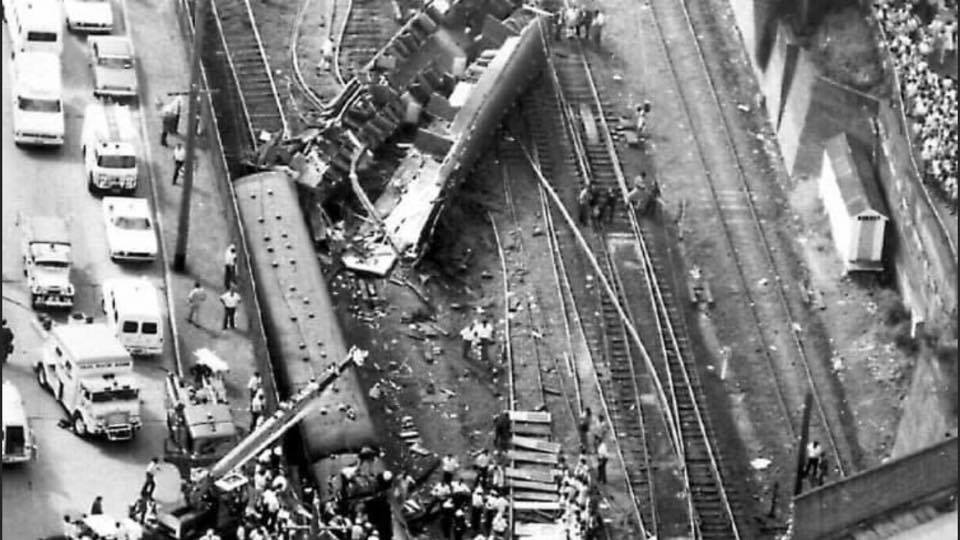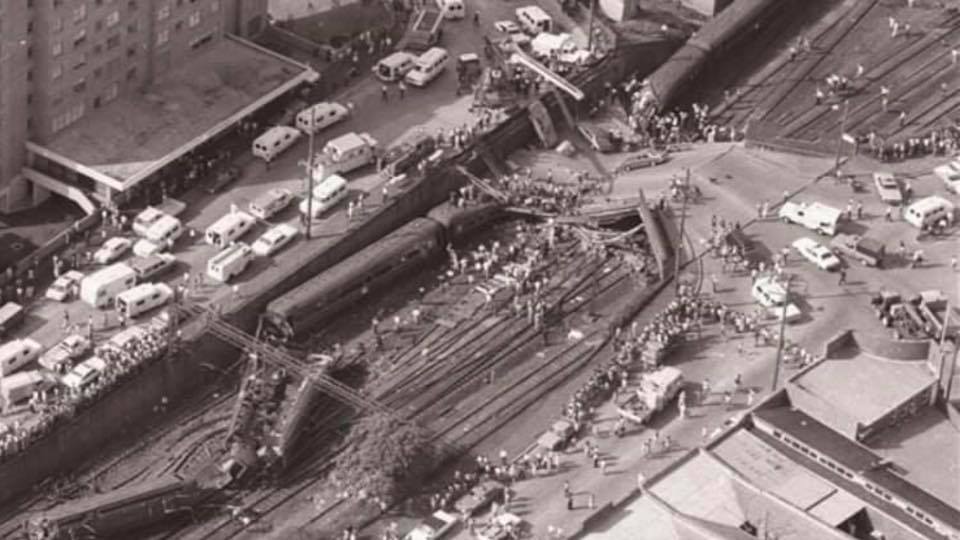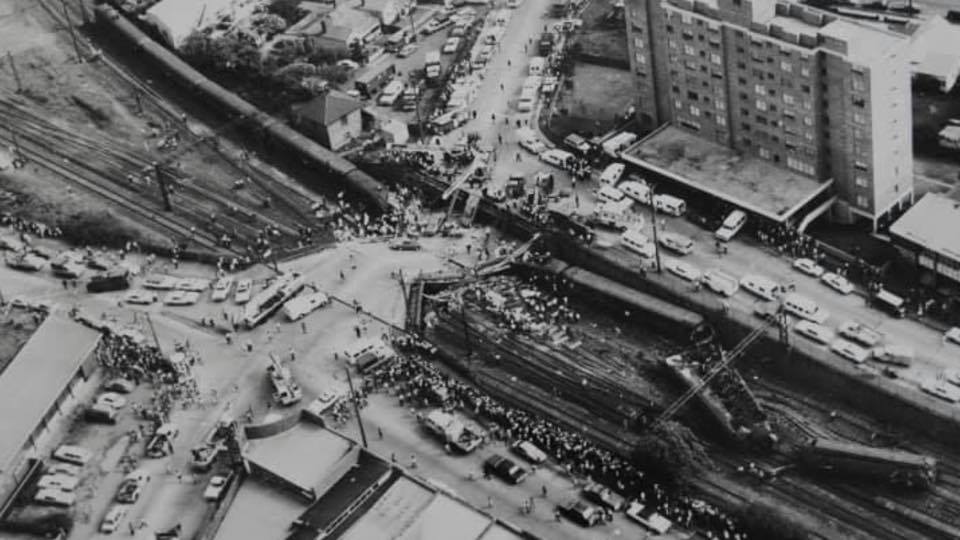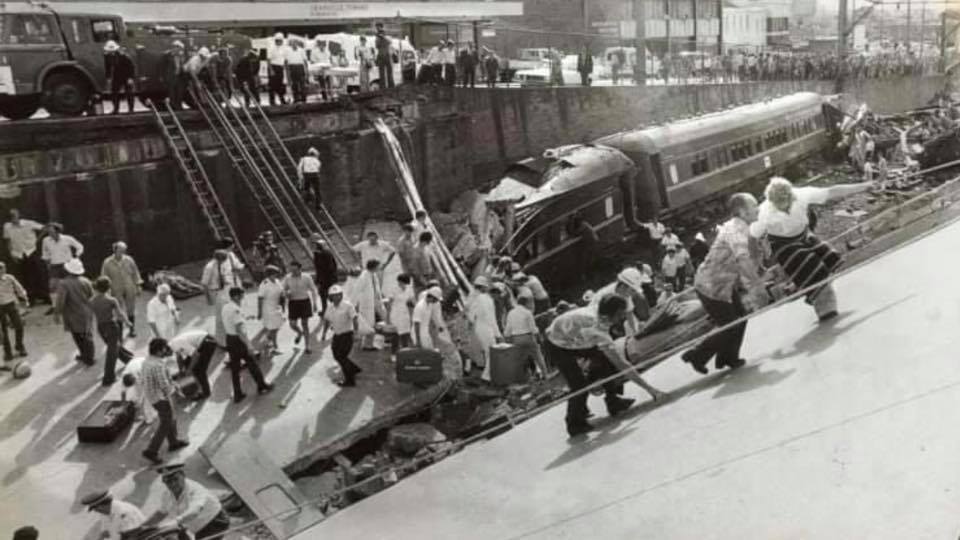On this day in 1977, the nation stopped to lend a hand when a train from the Blue Mountains, with some 469 passengers on board derailed at Sydney’s Granville suburb.
The Granville Train Disaster today marks it’s 44th year anniversary.
At 08.10am, its electric locomotive derailed on an 80km/h curve in a deep cutting at Granville and speared into the supports of the Bold Street bridge above the tracks.
The locomotive tipped on its side and dragged the first two carriages off the rails.
Eight people were killed in carriage one, which tore open as it hit a power stanchion. Everyone survived in the second carriage.
The bridge, with four cars on its deck, teetered for a few seconds, then rained at least 470 tonnes of concrete and steel down onto carriages three and four.

The weight crushed the roof of the wooden-framed carriages to within 60cm or less of the floor. Some areas were crushed to floor level.
Within minutes, a vast rescue assembled – police, firefighters, ambulance crews, doctors, nurses, engineers, railway workers among them.
The cutting hindered initial access until ladders, then stairs, could be erected.
The accident drew civilian volunteers – some just teenagers – to lend a hand but many ghoulish sightseers turned up.

Within an hour, 1500 people lined the cutting. The crowd spilled onto the tracks. Authorities say some disguised themselves as rescue workers and climbed onto the unstable bridge wreckage for a closer look, risking the lives of trapped passengers and their rescuers beneath.
Doctors, nurses and police rescue crews crawled into tiny spaces to reach the injured, with rubble above likely to shift and further compress the carriages.
In one instance, a police rescue officer was lying prone in a 35cm gap from floor to roof, clambering among victims’ bodies to get to an injured man.
A doctor had to amputate the arm of a dead woman to aid the rescuer but, without warning, a slab shifted above and compressed the carriage another 5cm, injuring the officer’s back.

Gas was leaking into the carriages, preventing the use of oxy-acetylene cutting equipment. Power lines had to be cut one by one before cranes could begin lifting pieces of the collapsed bridge. The stifling heat sapped the rescuers.
Compressed air did little to ease the sweltering conditions. Emergency lights strung through the carriages added to the heat.
Seven trapped passengers suffered potentially lethal crush syndrome – in which potassium, acids and other toxins built up in a person’s trapped limbs can be released quickly once they’re freed, causing life-threatening heart, respiratory and kidney issues.
Three died from it.
Granville became an object lesson in treating crush syndrome. One policeman used a knife to cut through seats and remove springs to ease pressure on trapped passengers.
The last living person was freed around 6pm that evening but died in hospital.
The last body was extracted 31 hours after the crash.
Tina Morgan, the youngest survivor of the disaster, said the scars from that day will never heal, saying: “It will never go away.
“For thousands of people involved, this will never go away, it’s major trauma,” she told the Australian Associated Press.
Ms Morgan, then 14, was trapped for at least five hours with her back injured and a piece of timber piercing her chest.
Of the 77 passengers in carriage three, 44 were killed.
In carriage four, 31 passengers out of 64 were killed.
The efforts of emergency workers were praised following the disaster, but a debrief a month later showed there were some problems.
In some instances, there was too much help on hand, crowding the scene.
A disaster simulation conducted near Granville only weeks earlier had prepared medical teams well, but the review found too many medicos came to the scene and could have been better used if directed to nearby hospitals.
Volunteers sometimes complicated things. At one stage, up to 30 people were observed trying to carry single stretchers.
Importantly, there was no plan for psychological support for emergency workers traumatised by the appalling scene. In all, one-quarter of emergency staff at Granville reported symptoms of anxiety, depression and insomnia a month later.
The National Association of Loss and Grief was established in 1977 in response, and commenced work with workers adversely affected by the disaster.
Psychological and pastoral care became more available to emergency service workers.
An inquiry headed by then NSW District Court chief judge, Justice James Staunton, began in February 1977. It revealed that the Bold Street bridge had been struck by derailments on the same section of track twice before – by a locomotive in 1967 and a loaded coal wagon in 1975.
The track there was in a “very unsatisfactory condition”, poorly fastened and badly aligned. The tracks had spread wider than standard gauge.
On the morning of the crash, this caused the locomotive’s front left wheel to drop inside the track and sent it careering into the bridge supports.
The defects should have been identified and repaired, with failures reaching into the highest echelons of the Public Transport Commission (although no-one was held directly accountable) and exacerbated by a high turnover of track inspection staff in the months before the disaster. Budgetary constraints were also a factor.
The Public Transport Commission ran at a loss of hundreds of millions of dollars a year.
Among his recommendations, Justice Staunton called for senior emergency personnel to be trained in disaster management and that more general training in crisis intervention be provided in crisis management for health and welfare workers in traumatic events.
The Wran government, which only came to power months before the accident, announced an immediate A$200m (£122m; $151m) railway improvement plan.
Each year since the Granville disaster, survivors, rescuers and loved ones of those killed gather on the Bold Street bridge on January 18 for a memorial service, dropping 83 roses to remember those lost.


